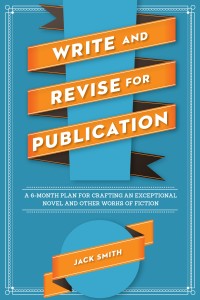Guest Post by Jack Smith
A strong opening to a novel is, of course, important. If the opening is boring or off-putting in any way, the reader is likely not to read on. It is true that some readers will be patient and hope things pick up, but naturally you can’t count on that. There are four basic opening types in fiction: exposition (I mean by this expository prose), description, narrative summary, and narrative scene. They are all used by published writers, and one isn’t better or worse than the others. What’s important is deciding which works best in your novel.
Exposition, as a rhetorical mode, means explanation. Writers are sometimes steered away from an expository opening for fear of mere telling. Who wants to read a long, boring presentation (or telling) of background information setting up the story? Readers want to get directly involved in the conflict; they want to be pulled in. But don’t fear the expository mode—instead, work it to your advantage.
- Sprinkle in some vivid description. How about this one from Mrs.Poe by Lynn Cullen:
“When given bad news, most women of my station can afford to slump onto their divans, their china cups slipping from their fingers to the carpet, their hair falling prettily from its pins, their fourteen starched petticoats compacting with a plush crunch. I am not one of them.”
The dominant rhetorical mode here is expository, but what makes it really work is the colorful description: “china cups slipping from their fingers to the carpet”; “their hair falling prettily from its pins”; “their fourteen starched petticoats compacting with a plush crunch.” This expository opening, then, is given some real flair.
- Provide an interesting insight or two. Note this expository opening from Man Martin’s Days of the Endless Corvette:
“We never came to complete agreement about Earl and the Endless Corvette: whether it kept him from going crazy or proved he was crazy from the get-go. Had he lived someplace else, there would have been no doubt, but because of Humble County’s history, we have a higher tolerance than most for craziness.
This is an expository opening, pure and simple. It attempts to “explain” why they never came to complete agreement about Earl and the “Endless Corvette.” Here’s it’s the humor, of course, that transforms mere explanation to something quite funny, and note that Twain-like snapper at the end: “a higher tolerance than most for craziness.”
- Create an interesting, compelling background for your characters. If the details you introduce are fascinating enough, exotic enough, or unique in some way, you’ll do fine with an expository opening. Consider this one, from E.L. Doctorow’s World’s Fair:
“I was born on Clinton Street in the Lower East Side. I was the next to youngest of six children, two boys, four girls. The two boys, Harry and Willy, were the oldest. My father was a musician, a violinist. He always made a good living. He and my mother had met in Russia and they married there, and then emigrated. My mother came from a family of musicians as well; that is how, in the course of things, she and my father had met.”
I find this reportorial style engaging. Here are the various family dynamics surrounding this narrator Rose’s life, and I want to know more about her. I want to know more about her mother and father and siblings. Doctorow pulls me in.
Don’t be put off by the expository opening. This kind of opening can capture the reader’s attention if you make it sparkle in some way. Each of the examples I’ve given are first person narrations. It is true that it can be more of a challenge with a third-person omniscient voice, but consider the opening to Toni Morrison’s Beloved, winner of the Pulitzer Prize.
“124 was spiteful. Full of a baby’s venom. The women in the house knew it and so did the children. For years each put up with the spite in his own way, but by 1873 Sethe and her daughter Denver were its only victims. The grandmother, Baby Suggs, was dead, and the sons, Howard and Buglar, had run away by the time they were thirteen years old . . . ”
This is third-person expository prose, and it works because it makes us wonder about “124” and all the characters Morrison mentions—not to mention the suspense hooks of “spiteful” and “baby’s venom.”
Try out the expository method. If you handle it well, it might be your best choice for your novel’s opening.
Jack Smith is author of the novel Hog to Hog, which won the George Garrett Fiction Prize (Texas Review Press. 2008), and is also the author of Write and Revise for Publication: A 6-Month Plan for Crafting an Exceptional Novel and Other Works of Fiction, published earlier this year by Writer’s Digest. His novel ICON will be published in June by Serving House Books.
Prize (Texas Review Press. 2008), and is also the author of Write and Revise for Publication: A 6-Month Plan for Crafting an Exceptional Novel and Other Works of Fiction, published earlier this year by Writer’s Digest. His novel ICON will be published in June by Serving House Books.
Over the years, Smith’s short stories have appeared in North American Review, Night Train, Texas Review, and Southern Review, to name a few. He has also written some 20 articles for Novel & Short Story Writer’s Market, as well as a dozen or so pieces for The Writer.He has published reviews in numerous literary journals, including Ploughshares, Georgia Review, Missouri Review, Prairie Schooner, American Review, Mid-American Review, and the Iowa Review.
Thanks for the great examples! That gives me ideas…
You know, I’ve never used the method for fear of that ‘telling’ bit, but I am currently listening to Outlander on tape and it begins very much this way “People disappear all the time…” I think it works well as a set up, given the right circumstances.
This is an interesting breakdown on an often overlooked subject. I’d hasten to add that mysteries and/or crime novels should, more often than not, begin with action. Back story can be sprinkled in throughout the rest of the narrative via dialogue and exposition (Elmore Leonard says this, more or less).
Great article. Thanks.
Exposition in the form of dialogue, like the examples shown, works so much better. Something about a character saying it rather than the narrator.
Exposition is interesting to me to read. I feel it’s more personal.
Great examples to highlight the exposition! Thanks :)
The expository opening is something I didn’t know about though, personally, I like the reportorial style—it’s clean and tells it like it is.
Elizabeth – Thanks for hosting Jack.
Jack – You make a good case for exposition in certain sorts of openings. When it’s handled well, it really can draw the reader in at that all-important beginning.
Jack–thanks for a good post on a thought-provoking topic. I think the key thing about expository openings is to know when enough is enough. This is where an outside editor can be invaluable. I wrote an expository beginning to a novel, but once I got a good editor, I realized I had definitely made the mistake of falling in love with my own words. It was just too much of a good thing. Which quickly morphed into a bad thing. I’m trying to fix that now, and will remember the lesson for next time.
I’m critiquing a novel with this type of opening right now. So far it’s an awesome read. Great to meet you, Jack. Hi from San Antonio!
Hey, thanks, everyone! I appreciate your comments a lot. Incidentally, the newest issue of The Writer magazine includes my article on openings and endings. If you get a chance, check it out. I interview several writers, Elizabeth included, on their ideas on starting and ending novels. I think you’ll enjoy it.